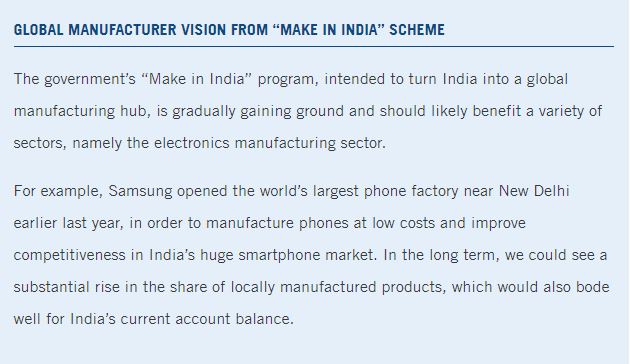India’s proposed corporate tax cut, which slashes the basic rate to 22% from 30% for domestic companies, is a welcome surprise.
The meaningful reduction in corporate rates sends a strong signal to investors that the Indian government recognizes the need to improve India’s economic growth and boost the corporate sector’s competitiveness.
This fiscal change comes at a time where India’s annualized gross domestic product (GDP) growth is slowing. In the second quarter of 2019, GDP grew by just 5%, marking the fifth consecutive quarter of declining growth.1 India’s growth fell behind that of China, which grew 6% in the second quarter.2
In the immediate aftermath of the tax announcement on September 20, India’s equity market reacted positively to the news, while the Indian rupee rallied. We’d also expect earnings to improve in the short term. However, bond markets declined on fears that the Indian government may now have to borrow more to meet the additional expenditure.
From a macro perspective, the proposed stimulus might not cost the government as much as it is made out to be. It’s estimated tax cuts could cost the government around US$20 billion. Though companies who want to take advantage of the new tax rate would not be eligible for other exemptions. We think the net figure of tax revenue foregone is more likely to be close to US$10 billion.
Improving India’s Competitiveness
In our view, corporate tax cuts should likely help boost capital expenditure and attract foreign investments to India. India’s corporate tax rate is now on par with its regional peers that have manufacturing hubs, such as Cambodia, Taiwan, Thailand and Vietnam. And, India’s corporate tax rate is now more competitive than China’s 25% rate.
New, lower corporate tax rates also included new manufacturing companies. Businesses that start operations between October 2019 and March 2023 would be eligible to apply for a 15% corporate income tax rate. This ties in with Prime Minister Narendra Modi’s “Make in India” initiative.

Sector Implications
Levels of impact will differ from sector to sector, particularly those subject to the highest effective tax rates.
At a company level, a reduction in the tax rate will likely boost cash holdings and increase corporate profitability. We’d expect company management teams to repay debt, pass on cost savings to consumers through lower pricing, or distribute dividends to shareholders through share buybacks.
For cash-rich companies, another potential consideration might be to resume capital expenditure (capex). We think this spending would likely bring a positive multiplier effect on the broader economy in the medium to long term.
As such, we favor high tax-paying companies that could potentially benefit from the structural transformation of the Indian economy.
Companies with existing plans for capacity expansion would directly benefit, but the tax cut alone is unlikely to trigger a wave of fresh capex from foreign companies. We believe the Indian government needs to make more progress on reforms. These include changes to land acquisition laws, labor laws and faster approvals processes to facilitate the revival of the capex cycle.
We also think the Indian government could propose more sector-specific stimulus. For example, the government could offer more housing-related benefits to increase housing demand. These measures won’t cost the government a lot, but it could boost discretionary income and impact consumer demand and therefore the economy.
Broadly speaking, the global industrial universe has spare capacity and is staring at a demand slowdown. That said, India has the potential to become a sustainable alternative hub for companies wanting to diversify manufacturing processes away from China.
We’d also expect banking names to receive a boost from companies being able to repay their debts, as a result of increased capital.
For the financial industry, some of the benefits of a lower tax rate might eventually be passed on to consumers in the medium term. Banks with alternative business segments, such as personal loans, credit cards or gold loans could stand to gain the most from the tax adjustment.
As long-term investors, we think India’s corporate tax cuts should help spur investment. As India grapples with slowing GDP growth, the Indian government has taken steps to give companies a boost to draw investors and restore confidence in the country’s dynamic economy.
To get insights from Franklin Templeton delivered to your inbox, subscribe to the Investment Adventures in Emerging Markets blog.
For timely investing tidbits, follow us on Twitter @FTI_Emerging and on LinkedIn.
The comments, opinions and analyses presented herein are for informational purposes only and should not be considered individual investment advice or recommendations to invest in any security or to adopt any investment strategy. Because market and economic conditions are subject to rapid change, comments, opinions and analyses are rendered as of the date of the posting and may change without notice.
The companies and case studies shown herein are used solely for illustrative purposes; any investment may or may not be currently held by any portfolio advised by Franklin Templeton Investments. The opinions are intended solely to provide insight into how securities are analyzed. The information provided is not a recommendation or individual investment advice for any particular security, strategy, or investment product and is not an indication of the trading intent of any Franklin Templeton managed portfolio. This is not a complete analysis of every material fact regarding any industry, security or investment and should not be viewed as an investment recommendation. This is intended to provide insight into the portfolio selection and research process. Factual statements are taken from sources considered reliable, but have not been independently verified for completeness or accuracy. These opinions may not be relied upon as investment advice or as an offer for any particular security.
Past performance is not an indicator or guarantee of future results.
Data from third-party sources may have been used in the preparation of this material and Franklin Templeton (“FT”) has not independently verified, validated or audited such data. FT accepts no liability whatsoever for any loss arising from use of this information, and reliance upon the comments, opinions and analyses in the material is at the sole discretion of the user. Products, services and information may not be available in all jurisdictions and are offered by FT affiliates and/or their distributors as local laws and regulations permit. Please consult your own professional adviser for further information on availability of products and services in your jurisdiction.
What Are the Risks?
All investments involve risks, including the possible loss of principal. Stock prices fluctuate, sometimes rapidly and dramatically, due to factors affecting individual companies, particular industries or sectors, or general market conditions. Investments in foreign securities involve special risks including currency fluctuations, economic instability and political developments. Investments in emerging markets, of which frontier markets are a subset, involve heightened risks related to the same factors, in addition to those associated with these markets’ smaller size, lesser liquidity and lack of established legal, political, business and social frameworks to support securities markets. Because these frameworks are typically even less developed in frontier markets, as well as various factors including the increased potential for extreme price volatility, illiquidity, trade barriers and exchange controls, the risks associated with emerging markets are magnified in frontier markets. Investments in fast-growing industries like the technology sector (which historically has been volatile) could result in increased price fluctuation, especially over the short term, due to the rapid pace of product change and development and changes in government regulation of companies emphasizing scientific or technological advancement.
_________________________
1. Source: India Ministry of Statistics and Programme Implementation, June 2019.
2. Source: National Bureau of Statistics, July 2019.




